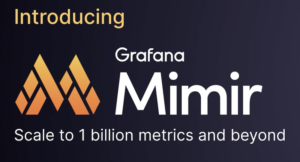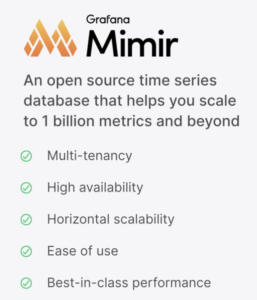
Grafana Labs Announces Mimir Time Series Database

Grafana Labs has announced a new project called Mimir, which is an open source, time series database that the company claims can be scaled beyond one billion metrics.
Time series databases are purpose built for handling time series data such as time stamped metrics or measurements. These databases can measure changes in data over a progression of time through tracking, monitoring, and aggregation. Examples of use cases include monitoring IoT and sensor data, weather data, and financial data such as stock prices. Metrics are one component of data observability, a quickly growing field of data science for which Grafana Labs builds dashboards for visualization of logs, metrics, and traces.
Founded in 2014, Grafana Labs is known for helping to launch the Cortex monitoring system, a Cloud Native Computing Foundation sandbox project from 2018 meant to allow users to query metrics from Prometheus servers in one single place. Cortex is licensed under Apache 2.0, an arrangement which the company says lowered its cost for larger companies using it, but not for its developers. It says cloud providers and ISVs have developed proprietary offerings based on Cortex using its open source code, but “without similar levels of contribution to the project,” a cycle that Grafana Labs says is unsustainable.
“Grafana Labs employees have been far and away the largest contributors to the Cortex project, with ~87% of the commits from 2019-2021,” said the company in a blog post announcement. To solve this problem, instead of keeping any Cortex improvements closed source, the company has developed Mimir as a fork of Cortex, with licensing through AGPLv3. Last year, the company also relicensed Grafana, Grafana Loki, and Grafana Tempo from Apache 2.0 to AGPLv3 for similar reasons. “From the beginning of Grafana Labs, our goal was to build a sustainable business around our open source projects, so that revenue from our commercial offerings could be re-invested in the technology and the community,” the company said. “The AGPL license helps balance the ‘value creation’ of open source and the community with the ‘value capture’ of our monetization strategy.”
Both Cortex and Mimir offer a horizontally scalable, clustered architecture, high availability through replication, long term storage on object storage, and advanced multi-tenancy and isolation. Mimir’s extended capabilities include high cardinality queries through a sharded query engine which the company says is “blazing fast” and 40x faster than Cortex, an API for identifying high cardinality metrics and labels, unlimited cardinality using a two-stage horizontally scalable compactor, and metrics ingestion that is compatible with Graphite, OpenTelemetry, Influx, and Datadog.
Mimir is launching as a 2.0 release because the company sees “Grafana Mimir 2.0 as the natural progression from the Cortex 1.x line,” and “has the resilience and scalability of a 2.x release.” Grafana Labs says that in addition to adding new features, it has removed previously required configuration options and increased automated self-care. The company says that “Just as Grafana is the one tool to visualize all your data, our mission is to make Mimir the one took to store all your metrics.”
The company said its Grafana Cloud and Grafana Enterprise Metrics products have already been using Mimir for months, and nothing will change for customers using those products. For those using Cortex, Mimir is available for migration as a drop-in replacement, which the company says is like a major version upgrade and can take less than 10 minutes on average.
In Mimir’s announcement, VP of Technology and original Cortex author Tom Wilkie said, “Now that we’ve released Mimir, users everywhere can put together the pieces of what I think is the most powerful, most comprehensive, and most composable open source observability stack, the LGTM stack: Loki for logs, Grafana for visualization, Tempo for tracing, and Mimir for metrics.”
For more details about Grafana Mimir, visit the Q&A with Grafana Labs CEO Raj Dutt, who was featured as a 2021 Datanami Person to Watch.
Related Items:
Who’s Winning In the $17B AIOps and Observability Market
Grafana Labs Upgrades Observability Platform

































